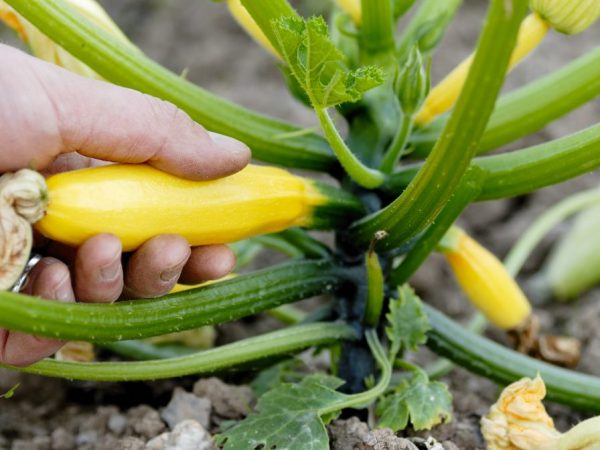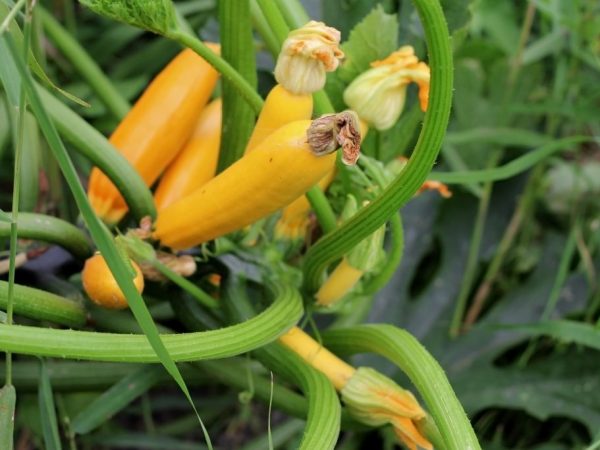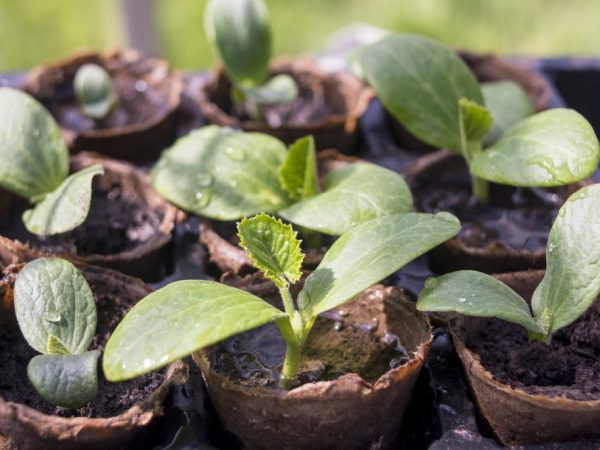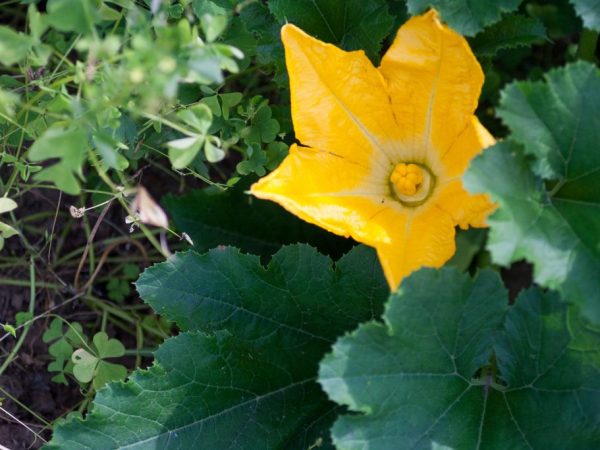Zucchini variety Zolotinka
One of the first zucchini yellow-fruited species that appeared in domestic vegetable growing, the zucchini Zolotinka. It has been grown in Russia since the 80s of the last century. The vegetable culture has gained popularity due to its high yield, good gastronomic quality and attractive appearance.

Zucchini variety Zolotinka
Variety description
Zucchini Zolotinka belongs to a variety of zucchini. It has a bright golden smooth skin that becomes more contrasting by the time it is fully ripe.
The average weight of oval-shaped fruits is 0.5-1 kg, length - up to 15 cm. The squash pulp is orange or yellow-orange, sweet in taste, crispy in structure, retains its original density when preserved. The pulp contains a high proportion of sugar (about 4.2%) and dry matter (about 8%).
The variety belongs to early maturing, ripens in 47-50 days from the moment the first shoots appear.
Bush plant with non-spreading leafy crown. Grows up to 0.45 in height. Able to release lashes by the second half of the growing season, which does not significantly affect the yield indicators. The foliage is light green, carved at the edges, with a characteristic pattern on the leaf blades in the form of light yellow or white fragments. Thorns on stems and petioles are absent, no pubescence. Inflorescences are bright yellow, self-pollinated.
Yield
Yield indicators are about 15 vegetables per bush.
- For industrial cultivation: up to 25-35 tons are harvested from 1 hectare.
- In a private economy: 8-10 kg per m² of planting area.
Harvesting
The high-yielding variety is ready to harvest 12-14 days after flowering. During the period of mass fruiting, vegetables are harvested twice at a weekly interval. Overgrown fruits lose gastronomic qualities characteristic of the variety.
Practical use
Zucchini varieties Zolotinka are suitable for preparing second courses, preserving and pickling, obtaining juices. They are among the types used in the production of baby food.
Disease susceptibility
Varietal is often affected by pests. Especially when cultivated in greenhouse conditions.
Parasites:
- spider mite;
- whitefly;
- melon aphid;
- sprout fly.
In rare cases, the varietal variety appears anthracnose (brown spot on foliage) and white rot. Vertex bacteriosis is affected when grown in greenhouse conditions at low temperatures and high humidity.
Prophylaxis

The plant does not like sudden changes in temperature.
As preventive measures, they use the basic rules of agricultural technology:
- observe crop rotation, changing the planting site every three years;
- digging up the soil to a sufficient depth during preparation in the fall, applying disinfection measures;
- destroy the remains of vegetation;
- when grown in greenhouses, maintain the temperature regime, avoiding sudden temperature changes;
- seeds are warmed up and disinfected before planting.
To protect the plantings, they use spraying with onion and garlic infusions, soap solutions.
Insecticidal agents in the fight against pests and infections are used only in case of massive damage to the plant, because the vegetable crop is early ripening.
Varietal advantages and disadvantages
According to the description of the variety, Zolotinka zucchini has a number of positive characteristics:
- early periods of fruiting and intensive ripening;
- the crop has good indicators of keeping quality, retaining its original appearance for a long time (from 2 months or longer);
- the variety is resistant to powdery mildew and a number of other diseases;
- high proportion of sugar content, therefore it is used in the production of juices, incl. for baby food;
- high yield rates;
Disadvantages of Zolotinka:
- thermophilicity and poor resistance to low temperatures;
- intensive overripening of vegetables with late harvest.
Features of agricultural technology
The variety of zucchini Zolotinka is grown under a film coating in greenhouse conditions or in open soil by seedling or non-seedling methods.
Basic cultivation rules:
- well-lit by the sun's rays, a place for planting a vegetable crop;
- highly fertile soil with neutral acidity, while adjusting the required acidity level allows the introduction of limestone or wood ash into the soil;
- observance of crop rotation and the correct selection of predecessors; for zucchini, potatoes and onions are the best predecessors;
- sufficient distance between the bushes, because Golden gold requires significant space, the interval between plantings should be at least 1.0 m;
- planting in a ground warmed up to 10˚C- 15˚C, the plant stops developing when the indicators drop to 8˚C, and with long-term frosts below this limit value, it dies.
Seed planting

Seedlings must be thinned out
When planting zucchini with seeds in greenhouse conditions or in open ground, 1.0-1.5 kg of compost and 3-5 seeds are placed in the holes at the same time.
After the appearance of the first leaves, the planting is thinned out, leaving only one, the strongest, plant in each hole. At the same time, excess shoots are not pulled out, but cut off at the root in order to avoid damage to the root system in a strong shoot.
In the absence of thinning plantings, the seedlings will stretch upwards, the lateral processes will be delayed in development, which will subsequently affect the time of the beginning of flowering and the formation of fruits.
When 4-5 leaves appear, the bushes are spud with moistened soil, which activates the growth and development of adventitious roots, which are necessary for enhanced plant nutrition.
Germination of seedlings
To obtain an early harvest, a seedling planting method is chosen. For germination of seedlings, peat milling tanks filled with a substrate for growing seedlings are suitable.
They begin to sow from the first days of May. The time of transplanting into open soil is after 25-30 days, i.e. in early June, when 2 or more true sheets appear.
In order to avoid the death of sprouts due to sudden frosts, they are covered with a film cover. Zucchini does not tolerate stagnant moisture well, therefore holes are made in the film at a distance of 1 cm. This will prevent condensation from building up. In conditions of steady warm weather, the film coating is removed.
Further care
Caring for zucchini includes the basic activities that are necessary when cultivating vegetables.
Weeding
Removing weeds allows you to maintain a full supply of mineral nutrition for the squash.
In the process of caring for vegetables, it is also required to remove the lower tier of foliage.This will provide good ventilation, which is a preventative measure against powdery mildew.
The petals remaining on the corollas of young ovaries are to be removed, which after some time, under the influence of moisture, begin to rot and cause rot on young vegetables.
Watering
The regularity of watering Zolotinka is once every 5 days with preliminary loosening of the upper layer of soil.
Top dressing

At the flowering stage, a second feeding is carried out
The first fertilizing feeding falls on the time when the second leaf appears on the sprouts. At the initial stage, organic matter is recommended as a fertilizer. The second and third feeding with mineral complexes is carried out at the flowering stage and during the period of fruit formation, respectively.
Avoid complexes containing a high percentage of nitrogen in the nitrate formation. It adversely affects the duration of the subsequent storage of vegetables.
With a delay in development and poor fruiting, the vegetable crop is fed with urea by the foliar method. Urea is diluted in the calculation of 1 tbsp. for 10 liters of water. Planting is sprayed with an interval of 10-15 days.
Pollination
For reproduction of the Zolotinki variety, zucchini are pollinated by hand, isolating male and female buds in the evening by tying them with a thick layer of gauze. In the morning, the pollen is transferred to the pistils with a cotton swab and the buds are again tied with gauze.
Common cultivation mistakes
When growing, gardeners make a number of typical mistakes that lower yields and worsen quality characteristics:
- Allow freezing of landings, without covering them at night. As a result, a decrease in temperature to 10'C and below becomes the reason for poor-quality pollination, which leads to the absence of ovaries, yellowing and decay.
- Feeding is carried out incorrectly. The absence of potassium or its insufficient proportion in mineral fertilizers leads to the appearance of deformed pear-shaped fruits, swollen from top to bottom. This can be corrected by fertilizing the plantings with ash (0.5 liters of powder under a bush) or by spraying with Uniflor-Bud (2 tsp per 10 liters of water). The absence of nitrogen in the soil leads, on the contrary, to the narrowing of the tips of vegetables and their lightening, it is permissible to make up for its deficiency by introducing manure or bird droppings.
- Do not follow the regularity of watering. Lack of moisture is the main cause of tip decay in large vegetables.
Conclusion
Zucchini of the Zolotinka variety is one of the first yellow-fruited species from the pumpkin family that appeared in domestic vegetable growing. Bred for early production of small vegetables.

